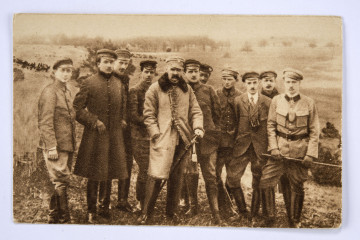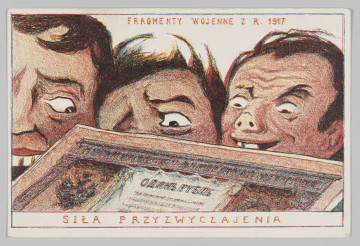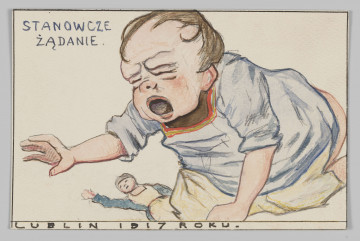
Postcard - Headquarters of P.O.W. during exercises in 1917
1917 — 1933
National Museum in Lublin
Part of the collection: Legion postcards
At the beginning of the 1930s, a Committee for the Construction of a Monument to the Fallen Peowiak (POW people), members of the underground Polish Military Organisation from 1914-1918, was established in Warsaw. Funds were collected from the sale of postcards with photographs of Polish Military Organisation officers from the First World War. One of them shows field exercises of the Supreme Command in Zielonka near Warsaw, which took place in May 1917. Among those posing for a photo alongside Józef Piłsudski were the brothers Janusz and Wacław Jędrzejewicz. The elder one, Janusz, headed the Ministry of Religious Denominations and Public Enlightenment in the Second Republic, and later served as Prime Minister. Wacław was Minister of Education in the interwar period. In exile, he established the Józef Piłsudski Institute of America.
Janusz Gąsiorowski, Brigadier General of the Polish Army, was among the Peowiakos who reached high military positions in independent Poland. The same happened to Henryk Krok-Paszkowski. A military career was chosen by Commander-in-Chief of the Polish Military Organisation Tadeusz Kasprzycki, Minister of Military Affairs until 1939.
During World War I, Bogusław Miedziński headed an expedition of the Supreme Command of the Polish Military Organisation to the territory of the Austrian occupation, with its headquarters in Lublin. In November 1918, he took part in the establishment of the Provisional Government in Lublin. In the interwar period, he was Minister of Post and Telegraph and parliamentarian. Karol Krzewski-Lilienfeld, a native of Lublin, one of the founders of the Piłsudski legend and a promoter of the Polish Legions' ethos, made a political career.
Jan Opieliński-Zdanowicz and Wacław Denhoff-Czarnocki died prematurely. The former was in charge of the POW in the area of the German occupation, with its headquarters in Warsaw. Sick with Spanish flu, he died in Lublin on 3 November 1918. The latter was commander of the Lublin District. During the Polish-Soviet War, he led intelligence units. He died in 1927 of tuberculosis. He was the originator of the "Polonia" Sports Club. In September 1939, Władysław Horyd, commander of the District POW in Siedlce, was killed.
Author / creator
Dimensions
cały obiekt: height: 14 cm, width: 9 cm
Object type
postcard
Technique
sepia
Material
paper
Creation time / dating
Creation / finding place
Owner
The National Museum in Lublin
Identification number
Location / status

1917 — 1933
National Museum in Lublin

1917
National Museum in Lublin

1917
National Museum in Lublin
DISCOVER this TOPIC
Museum of King Jan III's Palace at Wilanów
DISCOVER this PATH
Educational path